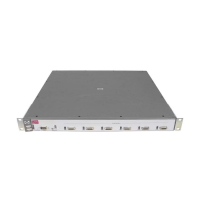Router Redundancy Using XRRP
Overview of XRRP Operation
XRRP Fail-Over Operation
If all access to a VLAN from one of the routers in the Protection Domain fails,
the routing function of that router is automatically transferred to the other
router in the Protection Domain. The master of the virtual router in the
Protection Domain sends out multicast advertisements at the XRRP advertise-
ment interval (every 5 seconds by default). If the other router in the Protection
Domain does not hear an advertisement packet within 3 advertisement inter-
vals, this other router will become the master router, and it takes control of
the IP address and the MAC address of the failed router.
Single VLAN Operation
In figure 12-3, the link between the layer-2 switch and Router-2 fails. As a result,
Router-2 no longer hears any link signals on VLAN 5 and the communication
between Router-2 and Router-1 is disabled. Router-1, after not hearing XRRP
packets from Router-2, will take over the IP addresses from Router-2 for the
VLAN 5 interfaces and it will take over the XRRP MAC address for Router-2.
Now Router-1 is the Master for its own IP addresses and the IP addresses for
Router-2 for VLAN 5, and it is the Master of its own XRRP MAC address and
the XRRP MAC address for Router-2. As far as the clients are concerned, the
transfer of router functionality is transparent – they can still get to the servers
using the same IP addresses and MAC addresses as before.
Figure 12-3. XRRP Fail-Over Example
12-5

